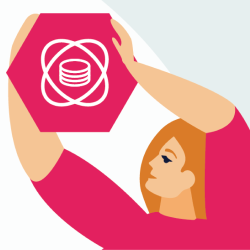Workforce Resilience: Empowering You
How do you plan for current and emerging technological challenges in a large federal agency like CMS? A key strategy for OIT is Workforce Resilience.
Workforce Resilience is the OIT program designed to cultivate a resilient and sustainable workforce for the future. The intent is to both cultivate a culture of learning and create a space for everyone to learn, innovate, and grow professionally. This way, we can grow to provide even more value to the millions of Americans who depend on us for their healthcare.
“We want to build a learning culture at OIT where our staff feel comfortable and confident in trying new things,” says CMS Chief Information Officer Rajiv Uppal.
A resilient workforce is equipped to adapt to evolving business needs and unexpected challenges like the pandemic. It goes beyond productivity to focus on making sustained improvements to employee well-being, interpersonal relationships, and work environment.
“We want people to learn key methodologies and principles as well as technical knowledge,” explains OIT Senior Technical Advisor Rick Lee. “We want to prepare our people for what’s to come and to take advantage of innovative technologies and solutions.”
The three core methodologies informing the Workforce Resilience initiative are Agile, Human-Centered Design (HCD) and Lean. A key goal of the initiative is for everyone at OIT to have foundational knowledge of Agile and learn how to incorporate the Agile approach into their work.
HCD and the closely related Design Thinking mindset comprises the second methodology. Whether you’re developing an application, creating an RFP, or delivering direct services to customers, integrating these methods into your approach can help identify unmet customer needs and add value to your work.
The third methodology is Lean, a systems thinking framework designed to organize work activities in a way that increases value and decreases waste. Lean thinking can help add context to your workflow and ensure that the work being done is effective.
The foundational Human-Centered Design + Agile Foundations + Lean Startup Overview (HALO) course covers these three core principles in an integrated and interactive approach. Register for the HALO Course today at:
Building upon the foundational concepts of Lean, Agile, and HCD, the Workforce Resilience program has five tracks that enable employees to develop their expertise in several key knowledge areas:
- HCD as a practice (above and beyond the core concept)
- Product management
- Cloud operations
- Cybersecurity
- Data science
Each track is delivered in levels: Awareness, Competency, and Engagement. These milestones in the learning journey are operated by subject matter experts in a coordinated approach.
The first level, Awareness, is designed for anyone of any skill level to familiarize themselves with a topic. This provides an entry point for all to participate in any area of interest so that we can develop a breadth of knowledge across disciplines.
The second level, Competency, teaches the core skills within a field. This level includes highly recommended, optional capstone projects offered by Workforce Resilience. These projects provide a prime opportunity to apply new skills and techniques in a real-world project within CMS, with mentor guidance available. Many of these courses are facilitated, while others are self-paced.
The third level, Engagement, encompasses the high-level specialized knowledge and skills one would need to become a CMS subject matter expert. Offerings are intensive and allow for schedule flexibility. OIT staff can expect further build out of Engagement level coursework once the Awareness and Competency levels are established.
The point is not to make everybody an expert in any of these fields. Rather, Workforce Resilience makes available the knowledge levels and tracks that best match each participant’s career development needs.
For example, if you want to learn about cybersecurity or cloud operations, improve your job performance, or build your skillset, the Awareness materials will resonate. If you want to lead a program within a specific track area, Competency will be the best fit. Finally, if you want to become a subject matter expert, you can work all the way through to the Engagement level.
Employees across multiple groups within and outside of OIT have contributed to building this program. Over the past 18 months, the team has been busy laying the foundation, including establishing the tracks, identifying subject matter experts to lead tracks, and developing the curriculum.
Workforce Resilience Program Manager Melissa Cohen, who has been instrumental in establishing this program, was able to use her training as a vector for fresh strategy. “When I started with CMS years ago, I would not have thought that I would have the opportunity to move from a communications background into leading the agency’s agile transformation and now the Workforce Resilience Program,” Cohen says. “It is great to have the opportunity to learn and grow within an organization and be able to apply those learnings in the work that we do every day.”
Feedback received from pilot course attendees was similarly positive. “I was able to learn and understand more about cybersecurity,” wrote one course attendee. “Privacy does not look the same as it looked before.” Another course attendee wrote, “I learned to look at IT differently: from the lens of the user, not the programmer.”
Top-line survey metrics collected after the pilot HALO course echo this sentiment. Nearly 87% of attendees said they were extremely likely or somewhat likely to use tools or concepts from the HALO course in their work. A similar number of attendees said they were likely to recommend the course to others.
Ultimately, the Workforce Resilience program enables OIT employees to pursue continuous learning in targeted areas so that they can bring their best capabilities to their work for CMS.

